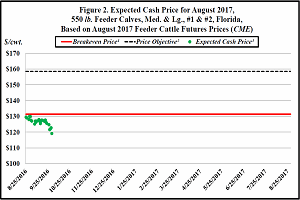By Chris Prevatt
The August 2017 Feeder Cattle futures contract decreased by $10.38/cwt. during September. Based on this futures price decrease, August Feeder Cattle revenues decreased by approximately $77.85/hd. ($10.38/cwt. *
7.5 cwt.) on a 750-pound feeder steer which amounts to $780 per truckload (50,000 lbs.). The August Feeder Cattle futures contract high, contract low, and price range since September 2016 are $128.00, $117.10, and
$10.90/cwt., respectively. The price range of $10.90/cwt. on a 750-pound feeder steer totals $81.75/hd. and $5,450.00 per truckload.


- The breakeven price was estimated to be $722.10/hd. or $131.29/cwt. ($722.10/hd. divided by 5.50 cwt.). The breakeven price includes production costs of $705/hd. and death loss of $17.10/hd.
- The price objective was estimated to be $872.10/hd. or $158.56/cwt. ($918.00/hd. divided by 5.50 cwt.). The price objective includes production costs of $705/hd., death loss ($17.10/hd.), family living withdrawal
- ($100/hd.), and growth capital/retirement ($50/hd.).
- The expected cash price is equal to the daily August 2017 Feeder Cattle futures closing price plus an expected August 2016 South Florida 550 lb. Feeder Calf Basis of $2/cwt.
Source: ufl.edu